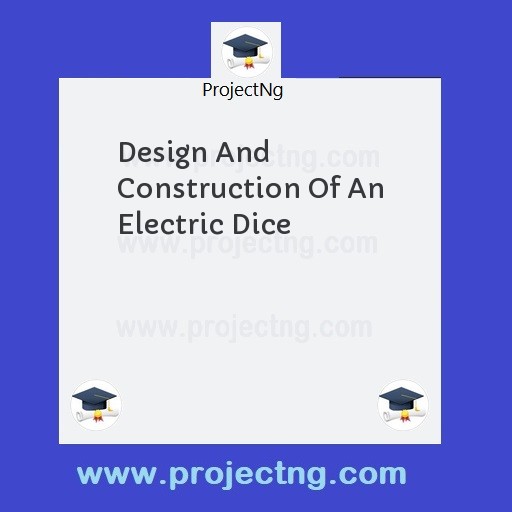Design And Construction Of An Electric Dice
Computer Science Project Topics
Get the Complete Project Materials Now! »
DESIGN AND CONSTRUCTION OF AN ELECTRIC DICE
CHAPTER ONE
INTRODUCTION
Instrumentation engineering has advanced widely with the introduction of medium scale integration (MIS), large scale Integration (LSI) and very large scale Integration (VLSI). For the purpose of accuracy and reliability analogue instruments are being replaced by the digital ones. The electronic dice display (EDD) with audio unit is among this now bread of instruments.
1.0 STATEMENT OF PROBLEM.
The design of an electronic dice display is invented because of the quest fort reducing strenuous activities encountered by man, especially on the area of its recreational activities. This device is used in ludo game. The ludo game on its manual operation, as he manipulated by the experts so that it can no longer be a game of chance. Sometimes players can employ tricks on their opponents which playing the game, for example if the both players are not vigilant, one of the them can event thwart the dice and claimed that nothing happened. The players too may get tired after playing two or three times because of the stress in shaking and playing the dice, the frequent hitting of the dice on the ludo board can even give cracks on the glass covering the ludo board. One can even experience the dice getting lost in the game because the dice is very small so if care is not taken, it can fall out from the board. All these problems were taken into consideration before constructing the electronic dice display.
1.1 PURPOSE OF THE STUDY.
As stated earlier, the design of this device is to help man conquer his environment. With the advent of medium scale integration (MSI), Integration circuit (IC) can be used to design devices that can help man perform his work effectively. With little or no stress and even sometimes at a cheaper rate. The device too will eradicate all the stress, tricks and pranks encountered when playing ludo game.
1.2 AIMS AND OBJECTIVES
The device will increase the fun derived from playing the game, even little kids can now join since they only need to press the buttons for the device to work. The game will now be purely based on chance because all bias will be eradicated, no expert can manipulate the device no matter how many times you use it. the normal phenomenon of playing tricks will be a thing of the past.
1.3 SCOPE OF THE STUDY
The work covered that playing and displaying of number got. This that the device when switched ON and STAR button is pressed, a particular number will be shown and this is the number the player got. This means that the player still need to get a ludo board and the seeds for the game.
1.4 LIMITATIONS OF THE STUDY
It will be an unfair treatment to this project if the discussion of the limitations that handicapped this important research work is overlooked. Hence, it is considered necessary for it will be a stepping stone for the improvement in further work.
The work is limited to just playing of the number got and the generation of sound through emphasis was not laid on the sound system. Part of the limitations in this project is as a result of their inclusion in the scope while others are due to constraints. The design specification was to achieve an electronic dice display that can display from 1 – 6. also the system is not protected from wrong voltage supplies. Voltage polarities wrongly connected or supplies greater than the specific supply voltage will damage the system.
Most of the constraints were due to lack of test with detailed information on the theory and the practice of electronic dice display (EDD). As 90% of the components are purely digital. They are not readily available on the market. Some of the components especially the transistors used sound display were not found in the market so I was forced to use the equivalent as specified in the data book and when some of these components are found, they are usually expensive.
Another problem was lack of equipment in the departmental laboratory for the executing and monitoring of the project. Some of the equipment used in the other department/ market were bad and gave false result. The oscilloscope used was not sophisticated enough to display very low frequency output of about 1Hz. Also, lack of textbooks was another serious problem. The few books seen treated components of dice display so shallowly. This calls for designing and re-designing till a working circuit was realized.
1.5 DEFINITION OF TERMS
AND GATE.
It is a circuit which gives a high outputs (ie logic 1 = high and logic O = low)an AND gate is represented by a dot to indicate it is a multiplication.
![]()
 A
A
![]() A.B
A.B
![]() B fig 1.0 AND GATE
B fig 1.0 AND GATE
CAPACITORS:
It provides a means of storing electrical energy in form of an electric field.
 |
Fig 1.1 Capacitor
COUNTER:
A circuit, which gives output pulse for every two inputs pulses. If the input pulses are irregular the circuit is regarded as counter. Counters usually come as integrated circuit.
Decoder/driver:
A decoder can be the reverse of an encoder circuit, there are a variety of decoders designed for specific purpose. In this case it is used as a code converter where it is required to convert from binary coded decimal (BCD) to decimal.
Diode:
Diode are two terminal devices which exhibit low resistance to current flow in the other.
Be the First to Share On Social















